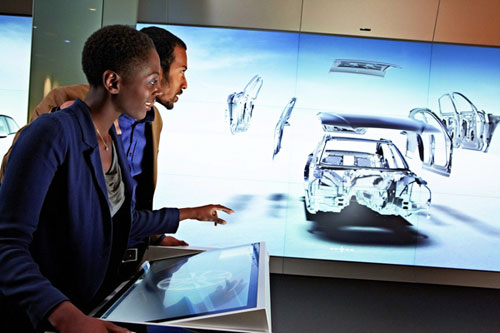In late June of this year, ‘global growth’ consultant Frost & Sullivan published a report on the state of automotive retailing—automotive being a key practice area for the firm. Here are some highlights from the USD 5k study, [1] most of which I needed to translate for my own understanding:
“Car ownership has become a lifestyle element with a technology-assisted environment deriving brand awareness and experience involving customers at all phases of the digital cycle.” – Neelam Barua, automotive & transportation team leader at Frost & Sullivan
Translation: Sorry, I don’t know what this means, but I‘m pretty sure the word ‘deriving’ has been used incorrectly. I’m off to a bad start here. Bear with me, please…
“50 to 60% of sales leads expected to come through digital means by 2016, compared to 15% in 2014”
This fits with the now-well-known fact that for high-involvement purchases, consumers do their research online and go to the store when they know what they want, or have a small set of options, and know what they should pay for them.
“Beyond 2020, digitization will enable lead conversion ratio improvements of more than 80%”
This, when added to the first prediction, will be a huge step forward for automotive retailing. It will mean the dealer sales person’s job is to be as knowledgeable on the brand as the consumer, and to negotiate the best option set and price for purchase, which may not include any significant discounting off the MSRP.
“Traditional dealerships and franchised outlets will give way to direct retail from the manufacturer (OEM) and digital showrooms by 2022.”
This is seismic change and it’s only seven years away, which means it’s already under way.
“Borrowing from retail tactics of technology companies, sales associates will be geniuses, similar to Apple’s store employees, or avatars.”
This works well in stores owned by the OEM, where sales associates are not paid on a commission basis. Hopefully, they are paid based on their delivery of good customer service. This is still diametrically opposed to the way sales associates are compensated in the traditional dealer model, resulting in a different customer experience that most consumers love to hate.
“Since 50% or more of sales leads will come from digital sources in 2016, 70% of the 2016 marketing budget is expected to go towards digital efforts.”
This prediction is a logical deduction from what comes before and I assume it refers to the OEM’s marketing budgets, since many retailers are already spending more on digital media than traditional. However, ‘digital’ is still very much the Wild West of the marketing mix, on the media side (see MW post PROGRAMMATIC: THE PROMISE & THE PROBLEMATIC) and on the creative side. It’s more than a bit frightening to think that next year, the majority of auto brands’ marketing spend will be in media with so much confusion surrounding it.
Context & Implications
The future of auto retailing is changing because the role of the automobile in our lives is changing. The car culture of the Baby Boomers is disappearing with them.
Here’s what Baby-Boom era car culture is: Buying and driving a car is an extremely visceral multi-sensual experience. Your chariot defines who you were. The process of driving is as important as the destination.
Take that away and there’s not much need for test-driving a car before you buy it, or seeing and touching it in a dealer’s lot. Or even owning one, if you are a true urbanite in a city with decent public transit.
Millennials have a very utilitarian view of the automobile, especially in major urban areas where all the population growth is, at least in Canada. They grew up being driven everywhere by their Baby Boomer parents, and they grew to really like it. This is the reason we have services like Zipcar and Uber and why cars will drive themselves. That and the fact that their doddering parents either aren’t available or they aren’t safe drivers any more.
The self-driving car will most likely come from technology companies like Google, Apple and Tesla (really a technology company dressed up like a car company, not that there’s anything wrong with that). Google and Apple already have the navigation and communication technology and can afford to strike a partnership with anyone on the automotive side. Tesla has the electric car technology (though not yet for the masses) and just needs to partner on the navigation side. The important difference is that Google and Apple already have the Millennials and Tesla does not.
So will the rise of the Millennial auto consumer make Frost & Sullivan’s predictions of seismic change in auto retailing come true? In my opinion, it will, but only in some segments will it be anywhere near the predicted timelines.
Frost & Sullivan’s research was focussed on the luxury end of the auto spectrum: Audi, BMW, Mercedes Benz, Porsche, Tesla, etc. Ford was the only North American OEM even mentioned the executive summary. Luxury auto brands have much higher sales profitability than the mass market OEMS, so they are better able to justify and afford expensive retail upgrades. More importantly, they have better flexibility and/or control of their dealer networks than the mass market OEMs. New brands like Tesla don’t have dealers. European brands like MB, BMW and Porsche have been moving towards corporately-owned stores for a while now, from different starting points. The big mass-market brands in North America have massive dealer networks and long term dealer contracts that make change at the retail level litigious and slow.
Here’s where Frost & Sullivan’s predictions will come true:
- Luxury brands in North America and Europe
- Brands in expanding consumer markets that don’t have dealer networks: China, India, Brazil, etc.
- Brands based on new technology that don’t have dealer networks anywhere: Tesla
One thing I believe will only come true in emerging consumer economy markets and ‘home countries’ in Europe: brand lifestyle stores—stores within and outside of the brand’s auto retailing stores that sell everything related to the brand’s lifestyle. This is the brand owner’s dream but not the way North American Millennials think about cars.
The Difficult Relationship between OEMs and their Dealers
Obviously, there’s more in this change for the OEM than there is for the dealer. OEMs want the 10% to 30% in retail margins on new vehicle sales and the service labour margin that dealer gets now. The manufacturers also want more standardisation and control of the brand experience at the retail level.
The dealer wants to stay in business, but not if it means massive investment in all-new retail facilities and not if they end up competing directly against their OEM’s retail stores.
The result in the medium term will be fewer, bigger North American dealers who own a portfolio of brands—something that wasn’t allowed in their contracts with OEMs in the heyday of car culture. This automotive dealer trend is already underway, to the point where some dealers have more regional all-brand revenue than some of their individual OEMs do nationally. These dealers will have the wherewithall to pick and choose the OEM brands that generate the best value.
Summary
- Seismic change is occurring in auto retailing but its eruption point and magnitude will depend on the market segment and market geography.
- A world where OEM-controlled digital marketing drives everything and OEM-owned retail is an extension of that digital sounds absolutely fantastic, but we’d better make sure we really understand the entire automotive consumer spectrum and the digital creative and media that reaches them.
- The real underlying trend here isn’t the digitisation of new car marketing, it’s OEMs selling direct to consumers. Despite the fact that Canada saw record new vehicle unit sales (1.85 M) in 2014, used vehicle sales are almost twice that and growing as the average age of vehicles on the road extends past 10 years. With significant global vehicle production over-capacity, OEMs know that for long-term diversified growth, they need to participate in service labour, certified used vehicle sales and purchase financing. Removing the dealer, which successful OEMs no longer need to finance their distribution networks, is the only way that can happen.
- Neelam Barua (Frost & Sullivan), Executive Outlook of the Future of Automotive Retail, June 29, 2015.
- Image credit: Audi City, Limité Magazine





